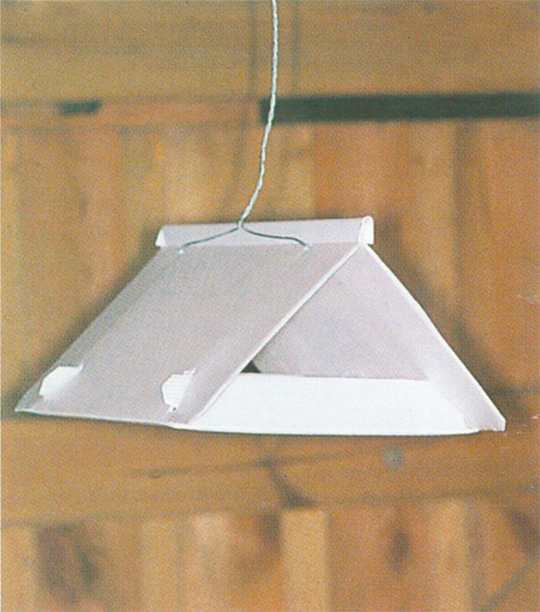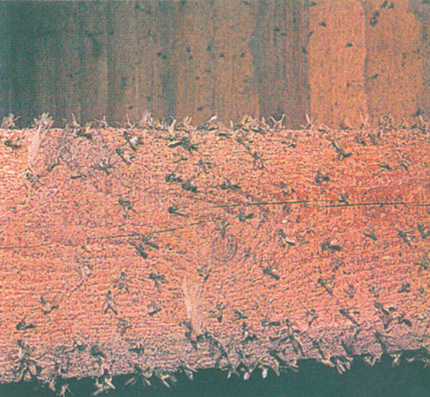Vacuum cleaners

There is no doubt that the daily use of a vacuum cleaner is the most important method of keeping pests under control, and this applies both to private houses and to industrial concerns. Many invertebrates are immediately killed and removed by vacuum cleaning. As already mentioned, some pests thrive best in places where there is a deposit of dust.
Fly swats
Fly swats can be a useful weapon when only a few gnats or flies have to be dealt with.
Heat
Insects are sensitive to high temperatures and will be killed in half an hour at 60° C this applies to eggs, larvae and adults.
Thus, heating clothing will kill all vermin in it, and heating foodstuffs or wooden objects may also prove a rational method of treatment.
Cold
At temperatures below 10° C most insects stop moving and developing and they cease to lay eggs. However, even lower temperatures are required to kill them, and there is considerable difference in the tolerance of the different species. Insects that are adapted to a temperate climate tolerate much lower temperatures in winter than those from the tropics (see p. 189). It is perhaps fortunate for man that a large number of household and foodstuff pests have come from warmer parts of the world. These cannot survive the winter in an unheated room, and they will, of course, be killed by deep-freezing.

Light traps
Many insects move towards the light and most of them are particularly attracted by light with a wavelength in the ultraviolet part of the spectrum. This light is invisible to us and is sometimes known colloquially as black light.
Entomologists have for a long time used light traps for collecting moths and other insects, and in more recent years there has been an increasing interest in using this type of apparatus for insect control. Light traps operate in different ways. The light may come from electric bulbs or from tubes, and the capture mechanism may involve either sucking the insects into a container by means of an air current, or attracting them to an electrically charged grille which kills them by electrocution. The dead insects then fall into a collection tray.
It has been shown that light traps are very effective against wasps. When correctly positioned they can keep bakeries and fruit shops practically free of these insects. Blowflies and many smaller flies and gnats are also caught, but in most cases it has been found that such traps are not very effective in dealing with common houseflies.
Light traps are not suitable for catching mosquitoes and other irritating insects on verandas, in vegetable gardens, etc. A light trap set up in the garden will certainly kill a large number of insects but it will attract still more to the area, and of those killed the majority will be harmless.
Other traps
For rats and mice traps will usually be the most effective method of control (see p. 87). The old-fashioned sticky flypapers can still be obtained in some places, but nowadays most people would find them rather ugly. Cockroach traps appear at intervals on the market but hitherto they have not proved very effective.
Radio-active irradiation
Broadly speaking such irradiation can affect insects in three ways. A relatively weak dose will increase the rate of mutation, a somewhat higher dose will sterilize the insects, and a really high dose will kill them. Insect populations have been successfully controlled by releasing sterilized males in such large numbers that all the females mated with them and subsequently laid infertile eggs. This method would not, however, be suitable for insects in the house. Radioactive irradiation has been used in some places for controlling pests in cereals, but the method is seldom economically viable, partly because the amount of irradiation required to kill an insect is very large, in fact about 500 times more than a human can tolerate.

Biological control
The release of predators, parasites or pathogenic micro-organisms, which keep down the numbers of pests, can be a very effective method of controlling agricultural pests. Domestic pests also have their natural enemies (see, e.g., p. 150) and possibly these could be used more effectively than they are at the moment. However, the problem is that in a house the need is for rapid and complete eradication, whereas natural enemies would normally only be able to keep the pest populations down to a certain level.
Chemical methods
When modern insecticides came into use at the beginning of the 1940s – DDT was the first – there was great optimism. These substances were effective against mosquitoes, flies, lice and fleas which spread disease, and against a wide range of plant pests, so that the earth’s total production of food could start to increase.
These insecticides are still very important weapons in the fight against hunger and disease, and many of them are extremely effective when used indoors. It has, however, been shown that their use is not so free from problems as was at first thought. In part this involves the much discussed poisoning and pollution of the environment (see p. 220) and in addition it was soon shown that some animals can develop a resistance to the poisons (p. 220).
Insecticides are obtainable in a variety of formulations. Powders, for example, are very suitable for treating cracks and crevices.
Sprays
Sprays are used when it is not practical to have powder lying about. In spite of their high cost aerosol sprays have become very widely used during recent years for household purposes. The contents usually consist of varying solutions of insecticide together with a propellant which pushes the solution out in the form of a fine spray. Insecticidal lacquers are used, for example, against cockroaches and ants. Their active principles are very dangerous poisons but their formulation has been so designed that the poison cannot spread but remains where the lacquer has been applied, usually in strips along walls and floors. Furthermore, the poison does not all come to the surface of the lacquer strips at the same time, but comes out little by little, so that a single application may be effective for several months.
In view of the many other efficient methods of treatment the use of poison gas is now fairly restricted. Thus, gas can be used against insect infestations in cereals, foodstuffs, tobacco and various groceries, and also in mills where it is used as a matter of routine to get rid of flour moths. Gas is also used in ships to kill rats, in order to prevent the spread of disease.
Timber, furs and hides can also be fumigated with gas.
The commonly used insecticides can be subdivided into four main groups, according to •their origin: 1) the so-called natural poisons derived from plants, 2) the chlorinated poisons, 3) the organic phosphorous compounds and 4) inorganic substances.
The most important plant poison is pyrethrum which is derived from a plant of the chrysanthemum group. It is not very poisonous to warm-blooded animals, but acts very rapidly on insects. Pyrethrum breaks down quickly when exposed to light and air, and it is sometimes incorporated in the insecticides that are used indoors, as it does not constitute a hazard to foods.
Rotenone or derris, obtained from various tropical plants, is used particularly against vermin.
The chlorinated insecticides, such as DDT and lindane, are not particularly poisonous to warm-blooded animals, but the objections to their use depend on the fact that they break down very slowly. This coupled with the fact that they are fat-soluble, means that they have a tendency to accumulate in the fatty tissues of animals. Chlorinated insecticides are incorporated in various ant powders and in certain timber preservatives where durability is required. Dieldrin is considerably more poisonous than the substances mentioned above, and its use is now mainly restricted to insecticidal lacquers and to some timber preservatives.
The organic phosphorus compounds include parathion which is extremely poisonous and must not therefore be used indoors. On the other hand, the substances in this group break down relatively quickly in nature and do not therefore present a serious pollution problem.
The inorganic substances used in powder form against insects include boric acid and kieselguhr.
Some insecticides have to be eaten by the insect before they are effective. These can be incorporated in the food, as for example when woollen goods are impregnated against clothes moths or timber against wood-boring insects, or they can be put in food supplied as bait.
Some insecticidal powders also act on the alimentary tract and the insects acquire these when cleaning themselves with their mouth parts.
Other insecticides work through the skin, as contact poisons. In fact, most of the modern synthetic insecticides (sprays, powders and lacquers) act in this way.
Gases work on the insects’ respiratory system.
This division into categories is not completely sharp. Some of the alimentary poisons have a slight action as contact poisons, and most of the contact poisons are also effective when they reach the stomach.




